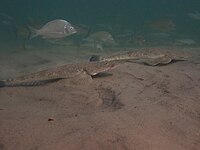Dusky flathead
The Dusky flathead, scientifically known as Platycephalus fuscus, is a popular sport fish endemic to the coastal waters of eastern Australia. Noted for its elongated body and distinct color patterns, this species plays a pivotal role in recreational fishing in its range. Its behavior typically involves lurking on the seabed, waiting for prey, while its breeding habits involve laying eggs in shallow estuaries.
Identifying[edit | edit source]
Dusky flatheads showcase a distinct mottled pattern on their body with brownish-gray on the upper side and white on the underside. They possess a flat head with tiny spines, and their appearance can vary slightly based on age and environment, with juveniles showcasing brighter patterns.
Similar species[edit | edit source]
| Fish | Difference in appearance |
|---|---|
| flathead-species1.jpg Bartail flathead |
The Bartail flathead tends to be more greenish and lacks the pronounced mottling of the Dusky. |
| flathead-species2.jpg Southern sand flathead |
This species is generally more uniform in color, without the pronounced patterns of the Dusky flathead. |
How to catch[edit | edit source]
Dusky flatheads are ambush predators, often found lurking in sandy or muddy bottoms in estuaries and coastal waters. Anglers often find success during the summer months when the fish are more active and come into shallower waters.
Where & when[edit | edit source]
The best locations to fish for Dusky flatheads include estuaries, bays, and coastal beaches of eastern Australia. The ideal time to fish is during the warmer months, from December to March, when they come into shallow waters for breeding.
Rods, reels and lines[edit | edit source]
A medium-action rod paired with a 2500 to 4000 size spinning reel is typically recommended. Braided line of 10-15 lb paired with a fluorocarbon leader works well, with popular brands like Shimano and Daiwa being the top choices among anglers.
Bait & lures[edit | edit source]
Live bait such as prawns, small fish, and yabbies work effectively. When it comes to lures, soft plastics resembling baitfish or prawns, and diving crankbaits are the top choices.
Techniques[edit | edit source]
Cast and retrieve technique, where the angler casts the lure and retrieves it with intermittent twitches, mimicking a wounded prey, is often effective. Slow jigging on the bottom can also entice a bite from lurking flatheads.


